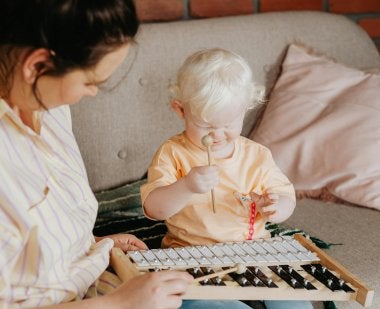
We recently wrote about the importance of Music in Early Childhood. This week, we interviewed Nancy Nuttle, Director of Music Together Montgomery in Montgomery County, Maryland. Ms. Nuttle has a Bachelor of Science degree in Music Education, completed 15 successful years of general music instruction in Montgomery County Public Schools, and has sung professionally. We asked Ms. Nuttle to help us think about how Early Childhood educators can bring music into their classrooms.
Can you describe the Music Together teaching philosophy?
The Music Together® philosophy is based on research that indicates all children are musical, meaning we are all born with some level of music aptitude just as we are all born with the aptitude for language acquisition. Our goal is to empower parents and primary caregivers to support a child's music development as they journey towards basic music competency in a playful, non-performance-oriented environment that is developmentally appropriate for children birth through 5.
Why do you think music is an important part of early childhood education?
Research indicates young children are wired for music-learning. Music-making is one of the human attributes that reside at the core of what makes us human. For this reason, we believe that the inclusion of music, for music's sake, is a birthright and should be an integral part of early learning.
What are some ways that early childhood general and special educators can bring music to their classrooms/weave music throughout the day?
Singing and music-making can easily be incorporated into a child's daily routine. Beginning and ending the day with ritual songs help children transition through their day. Providing opportunities for children to experiment with singing and instrument-play and exposing children to listening experiences that involve large movement respects a child's need to move and supports the spiral of exposure and experimentation that is so essential to the early childhood learning process.
Any specific activities you would recommend?
Music-learning, as with language-learning, in early childhood is all about adults modeling with children having the freedom to choose to participate. Singing songs without words allows children to have musical experiences without the distraction of language. Providing opportunities for older children to volunteer verse ideas during a song helps children feel invested in music-making and their ideas appreciated. Music-making experiences where adults model playing simple instruments, such as egg shakers, drums, and other child-friendly instruments, allow children to participate at whatever level is developmentally appropriate without performance expectations.
Music Together has developed a curriculum I feel is the gold standard regarding the inclusion of the entire school community, especially parents.
Any tips for creating music centers in early childhood classrooms?
Most preschools are set up with a block area, kitchen area, art area, and reading area. For children to have opportunities to discover, create, and explore music themselves they need a similar “music area” in their classrooms. A music area should contain equipment and manipulatives that support such explorations: simple age-appropriate instruments like rhythm sticks, egg shakers, small drums, and scarves, along with a recording device so music can be played. Recordings of different genres of music give children lots of "musical vitamins." Classical, jazz, folk music, world music, etc. are all great choices; don’t limit yourself to "kids" recordings! Songbooks that provide a visual representation of music allow children exposure to musical notation and serve as pre-literacy tools. Just as a child might "read" a book before they can actually read the words, they also "read" music, thus beginning the process of connecting notation to sound.
Where can educators find affordable materials?
Our voices and bodies should be the number-one source for music-making for young children. Kitchen utensils, recycled, child-friendly containers are a good source. Homemade instruments are the most affordable, of course! Music Together’s online store also sells a number of child-friendly instruments and materials, all tested and high quality. There are other online resources like West Music, Rhythm Band, Remo Inc. as well. When purchasing instruments for your classroom, investing in quality, kid-friendly instruments is worth it!
Any other resources you would recommend?
The Music Together website contains a wealth of information on music in a school setting. The three-day Music Together teacher training is accredited by many institutions for CEUs (continuing education units) towards teaching certificates in many states. We focus on how children develop musically and what adults need to do to support this natural process.
Any other points you would like to touch on?
Preschool teachers often feel unqualified to "teach" music. Quite simply, the joy of music-making should be modeled by all educational professionals working on a daily basis with young children regardless of the adult's skill level.
Resources
- Read more about Music Together For Schools
- Read more about the role of music in Early Childhood in this Position Statement from NAFME
The Center for Early Childhood Education and Intervention conducts high quality research on early childhood education and early intervention programs. You can follow us on X at @CECEIatUMD.